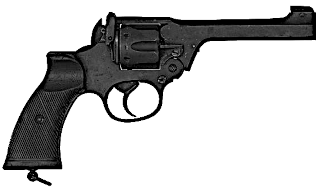Enfield No 2 Mk 1 Revolver also known simply as the Enfield Mk 1 or Enfield No. 2 and sometimes mistaken as a Webley is a British top-break revolver chambered in .38 S&W and manufactured from 1930 to 1957. The design is a solid single-piece enclosed frame with centralized revolving cylinder. It has a 5-inch long barrel that is forged as part of the forward section of frame. A lanyard ring was fitted to a post under the grip. The gun weighed about 27 ounces, almost a pound lighter than the 40-ounce Webley .455.

British Service, Pistol, Revolver, Number 2, Mark I
There are three types or variants of the Enfield No 2 Mk 1 Revolver.
- Mk.I - (1930 - 1939) full-spur hammer, double-action/single-action, wood grips
- Mk.I* - (June 1938 - ) spurless hammer, double action only, plastic grips
- Mk.I** - (July 1942 - ) no hammer safety and simplified for mass production
- The Enfield No. 2 Mk. 1* was introduced in 1938 and remained in production until 1943 when it was replaced by the later Mk 1**
- variants: Mk.I's were converted to Mk.I*s. After WW2 some Mk.I**s may have had hammer safety reintroduced. Other conversions.
The British Government was given the option to purchase a Webley & Scott .38 caliber design that was already in use by civilian police, however, decided to create their own. The British Army copied the basic police Webley 38 design given to the Royal Small Arms Factory (RSAF). Revisions included a new trigger mechanism and revised lockwork.
Webley sued the British Government for £2,250, being "costs involved in the research and design" of the revolver. Their action was contested by Enfield, who stated that the Enfield No 2 Mk I was actually designed by the Assistant Superintendent of Design Captain Boys with assistance from Webley & Scott. By way of compensation the Royal Commission on Awards to Inventors awarded Webley & Scott £1,250 as a way to settle the dispute.
The vast majority of Enfield No 2 revolvers were made by Enfield, however, other manufactures also produced them to help increase wartime numbers. Some companies involved included:
- Albion Motors in Scotland - produced Mk I* (1941 to 1943)
- Coventry Gauge & Tool Co.
- Singer Sewing Machine Company of Clydebank (parts only not final assembly)
- Howard Auto Cultivator Company (HAC) New South Wales, Australia (limited production)
Enfield was ordered to create a handgun design based on a .38-caliber cartridge with a 200-grain lead bullet and a short case, roughly equivalent to the .38 S&W or the .38 Colt New Police. This made for recoil of around 800fps. The original trigger pull on the Mk I was 15-pounds. This was reduced in the Mk I* to a mere 11-to-13 pounds.
Tank crewman were isued the Enfield No 2 Mk.I* double action only variant, the one without the hammer spur, because they didn’t want hammer spurs hanging up or snagging on something in emergencies, like jumping out of a burning tank. This version was standardized upon to guarantee that British tanker crews received the appropriate model.
Owners of the pistol might notice that it will shoot low using modern .38 S&W (.38 S&W, NOT .38 S&W Special). People are known to shoot .38 S&W ammo sold in light 148-grain LRN target loads with good results.